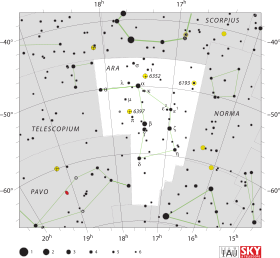HD 153221
HD 153221
| Ascension droite | 17h 00m 26,95941s[1] |
|---|---|
| Déclinaison | −48° 38′ 51,9319″[1] |
| Constellation | Autel |
| Magnitude apparente | 6,00[2] (6,34 + 7,69)[3] |
Localisation dans la constellation : Autel | |
| Type spectral | G8 / K0 III + G[4] |
|---|---|
| Indice B-V | +0,88[2] |
| Vitesse radiale | −28,6 km/s[5] |
|---|---|
| Mouvement propre |
μα = −17,93 mas/a[1] μδ = −80,49 mas/a[1] |
| Parallaxe | 9,36 ± 0,75 mas[1] |
| Distance |
350 ± 30 al (107 ± 9 pc) |
| Luminosité | 49,5 L☉[6] |
|---|---|
| Température | 4 993 K[6] |
| Rotation | 4,4 km/s[7] |
Désignations
HD 153221 est une étoile double de la constellation de l'Autel. À partir de 2012, la paire a une séparation angulaire de 1,10" et un angle de position de 172°[3].
Références[modifier | modifier le code]
- (en) Cet article est partiellement ou en totalité issu de l’article de Wikipédia en anglais intitulé « HD 153221 » (voir la liste des auteurs).
- F. van Leeuwen, « Validation of the new Hipparcos reduction », Astronomy and Astrophysics, vol. 474, , p. 653–664 (ISSN 0004-6361, DOI 10.1051/0004-6361:20078357, lire en ligne, consulté le )
- B. Nicolet, « Catalogue of homogeneous data in the UBV photoelectric photometric system. », Astronomy and Astrophysics Supplement Series, vol. 34, , p. 1–49 (ISSN 0365-0138, lire en ligne, consulté le )
- Brian D. Mason, Gary L. Wycoff, William I. Hartkopf et Geoffrey G. Douglass, « The 2001 US Naval Observatory Double Star CD-ROM. I. The Washington Double Star Catalog », The Astronomical Journal, vol. 122, , p. 3466–3471 (ISSN 0004-6256, DOI 10.1086/323920, lire en ligne, consulté le )
- Nancy Houk, Michigan catalogue of two-dimensional spectral types for the HD stars, (lire en ligne)
- D. S. Evans, « The Revision of the General Catalogue of Radial Velocities », University of Toronto, vol. 30, , p. 57 (lire en ligne, consulté le )
- I. McDonald, A. A. Zijlstra et M. L. Boyer, « Fundamental parameters and infrared excesses of Hipparcos stars », Monthly Notices of the Royal Astronomical Society, vol. 427, , p. 343–357 (ISSN 0035-8711, DOI 10.1111/j.1365-2966.2012.21873.x, lire en ligne, consulté le )
- C. Schröder, A. Reiners et J. H. M. M. Schmitt, « Ca II HK emission in rapidly rotating stars. Evidence for an onset of the solar-type dynamo », Astronomy and Astrophysics, vol. 493, , p. 1099–1107 (ISSN 0004-6361, DOI 10.1051/0004-6361:200810377, lire en ligne, consulté le )
Liens externes[modifier | modifier le code]
- Ressource relative à l'astronomie :

